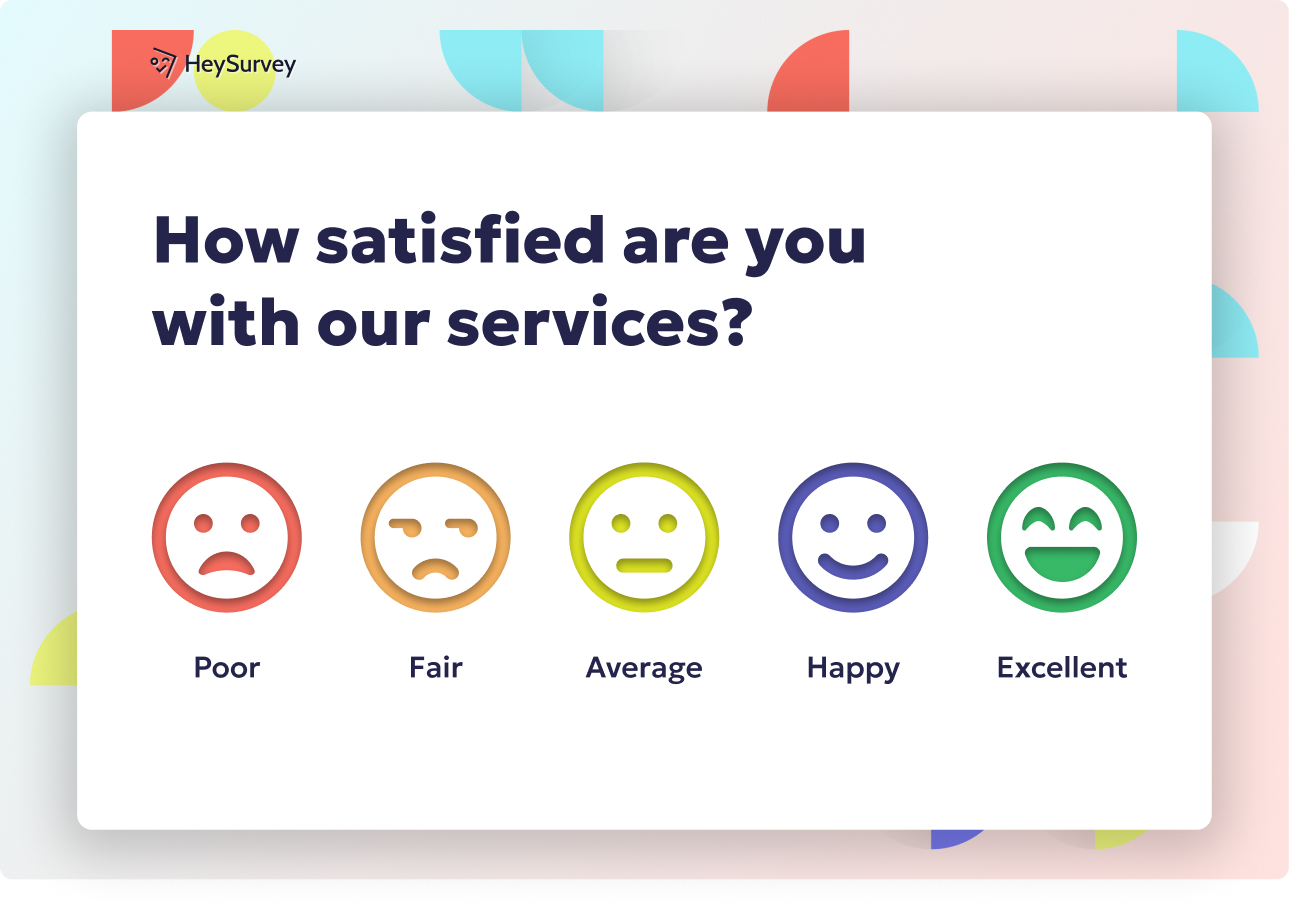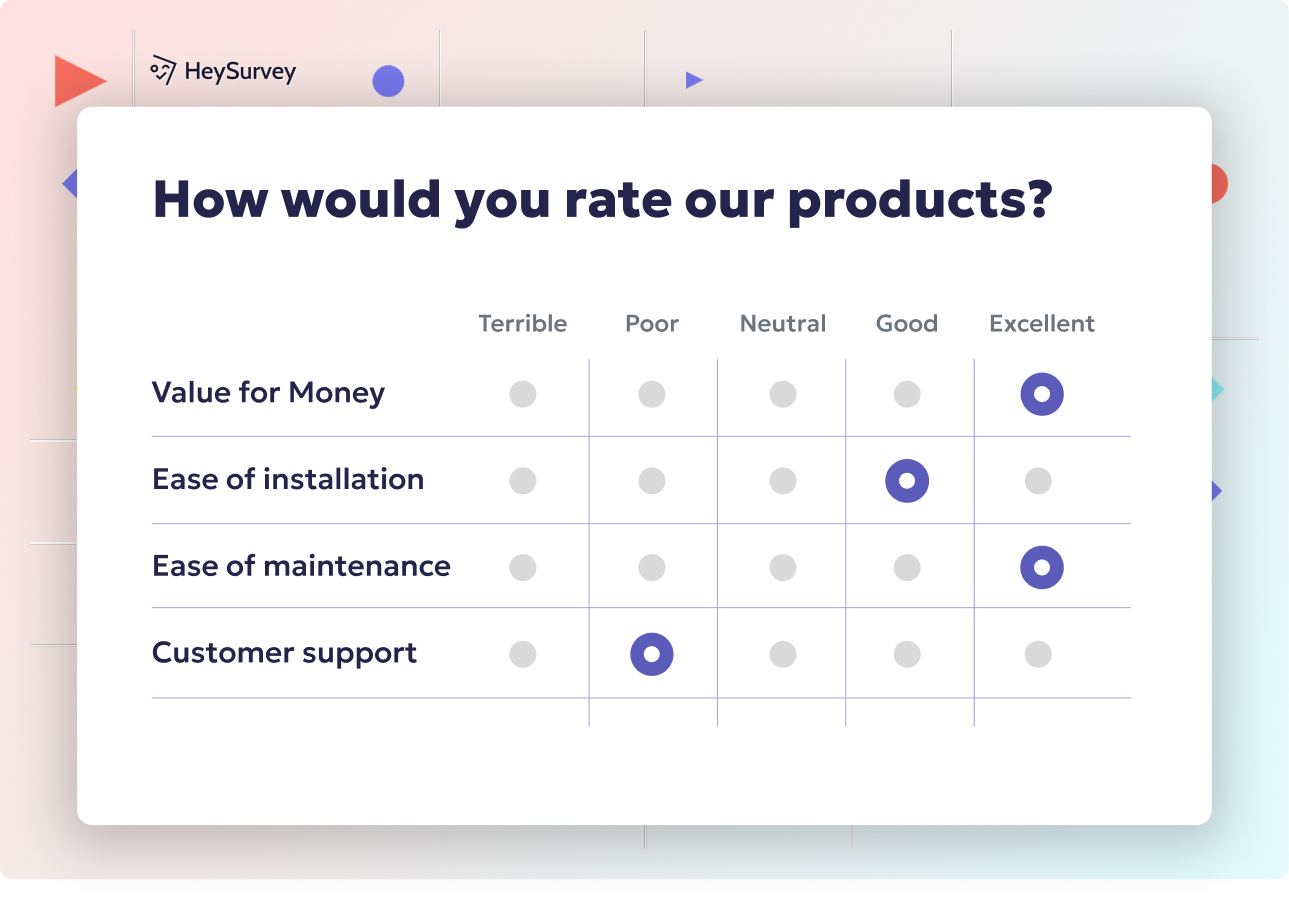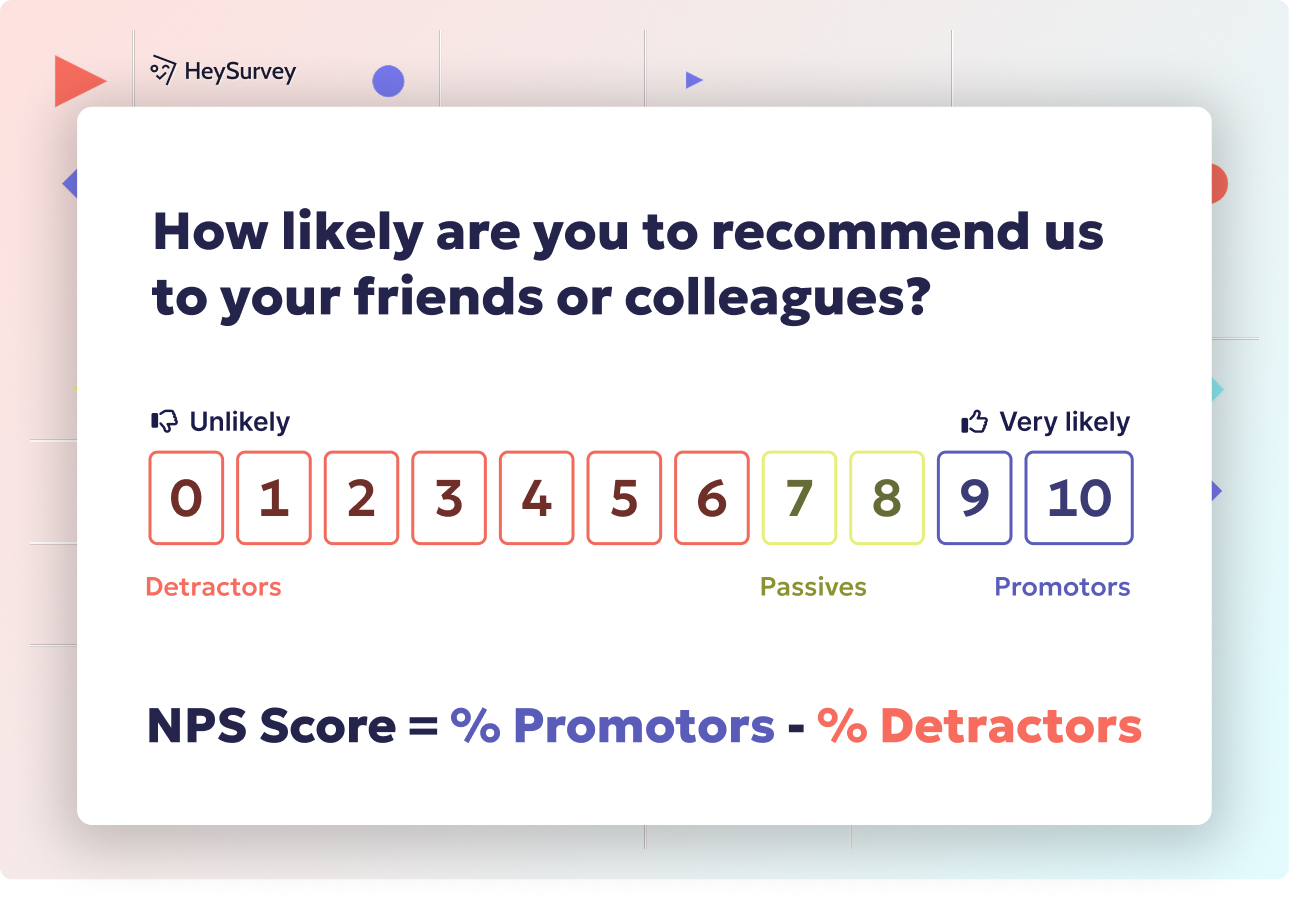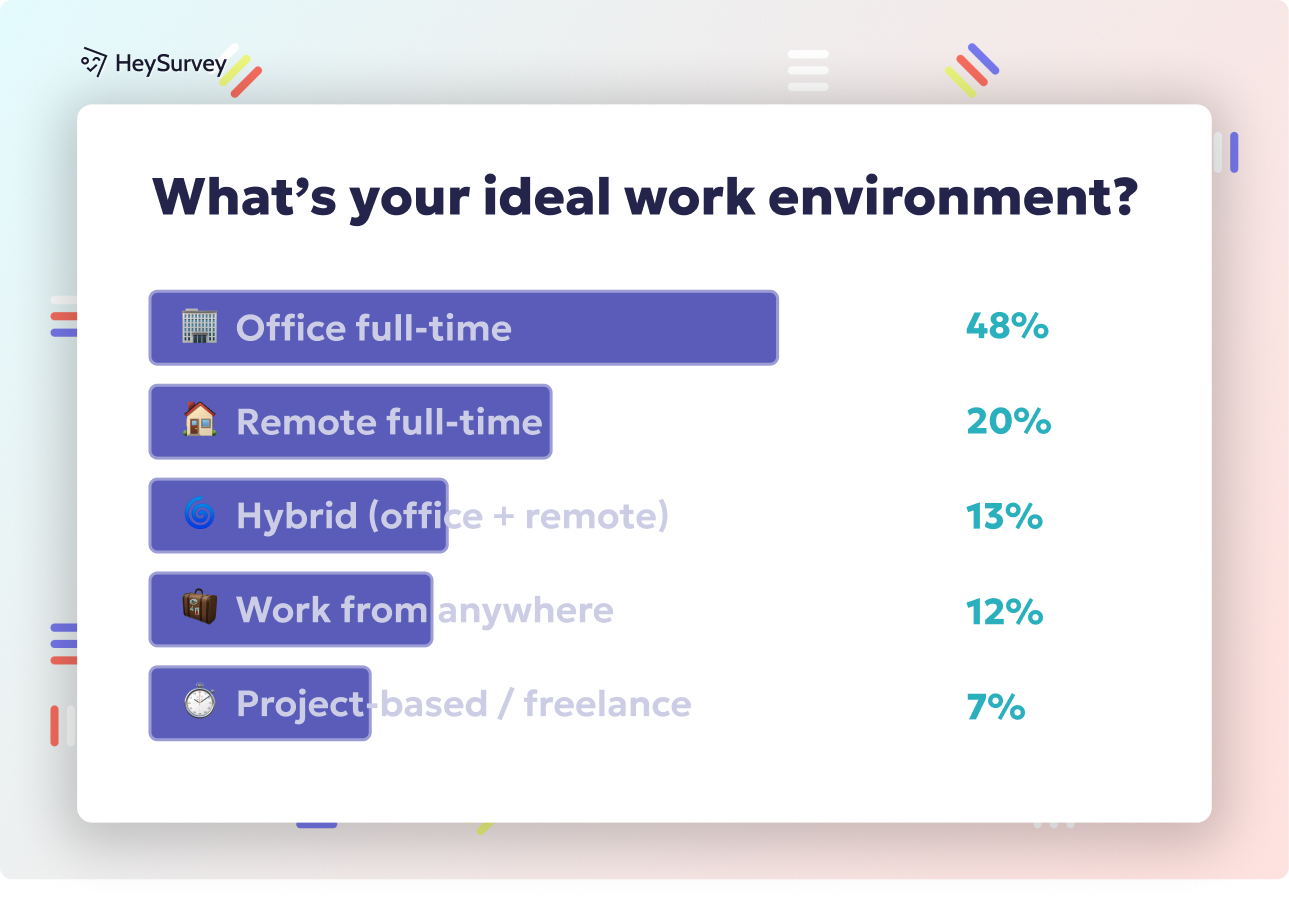32 Nutrition Survey Questions: Types, Uses & Best Practices
Discover 25+ expert nutrition survey questions covering types, uses, and best practices to enhance data quality and engagement.
Nutrition affects every bite, every choice, every day—making nutrition survey questions vital for discovering what people eat, why, and how it impacts their health. A good nutrition survey offers clear benefits in research, workplace wellness, product creation, and customizing eating plans. Picking the right survey method ensures data is meaningful, respondent fatigue is minimal, and results are actionable. In this guide, you’ll find eight key types of nutrition surveys, each explained simply, with real use cases and handy, ready-to-use example questions to streamline your next survey.
Dietary Habits Survey
Why & When to Use This Survey Type
Understanding everyday dietary patterns is crucial for anyone looking to improve public health or individual lifestyles. A dietary habits survey digs into regular food choices, meal timings, portion sizes, and even cooking methods. It's the go-to choice for baseline assessments in nutrition programs, especially those aimed at weight management or tracking dietary changes in large groups.
This survey type shines in epidemiological studies where the aim is spotting patterns that link eating behaviors to health outcomes. It's also perfectly suited for clinics or wellness programs wanting to personalize coaching or feedback. By pinning down "how" and "when" people eat, nutrition professionals can offer insights that actually stick.
Use this survey before rolling out interventions, setting up nutrition counseling, or even designing new menus at work or school. It's the foundation for many other assessments—because you can’t improve what you don’t measure.
Sample Dietary Habits Questions
- On how many days per week do you eat breakfast?
- What time do you usually have your first meal of the day?
- How many portions of vegetables do you eat daily?
- How often do you eat home-cooked meals versus takeout?
- Do you tend to eat until you're full, slightly satisfied, or still a bit hungry?
- Which cooking methods do you use most frequently (e.g., frying, baking, steaming)?
The Food Habits Questionnaire (FHQ) demonstrates satisfactory internal consistency (α = .73) and test-retest reliability (r = .74) in assessing fat-related dietary behaviors. (statisticssolutions.com)

Creating your nutrition survey with HeySurvey is easy and fun! Here’s how to get started in just three simple steps:
Step 1: Create a New Survey
- Go to HeySurvey and click “Create New Survey”.
- Choose to start from an empty sheet, use a pre-built template, or try the text input creation method. Templates speed up your work by providing a ready structure for nutrition surveys.
- Give your survey a name, something like “Dietary Habits Survey” or “Nutrient Intake Questionnaire” so it’s easy to find later.
Step 2: Add Your Questions
- Click the “Add Question” button at the top or between questions.
- Pick the question type that fits best—like Choice for multiple options or Scale for rating frequency.
- Enter your question text and add descriptions if you want to clarify a question.
- Set whether the question is required or optional.
- Add images or format text with markdown to make it engaging.
- Use the advanced settings to enable branching if some questions depend on earlier answers.
Step 3: Publish Your Survey
- When your survey looks ready, click “Preview” to see it as your respondents will.
- Make any last tweaks to design or flow.
- Hit “Publish”—note that you’ll need a HeySurvey account at this point to collect answers.
- You’ll get a shareable link to send out or embed in your website.
Bonus Steps to Make Your Survey Shine
- Apply Branding: Upload your logo and customize colors and fonts via the Designer Sidebar. This helps your survey feel polished and on brand.
- Define Settings: In the settings panel, set start/end dates, limit responses, add a redirect URL for after the survey, and control whether respondents see results.
- Use Branching: Create personalized pathways for your respondents by skipping irrelevant questions based on their answers—perfect for complex nutrition assessments.
Now you’re ready to roll with HeySurvey and collect valuable nutrition data with ease. Don’t forget to hit the button below to open a nutrition survey template and start customizing right away!
Nutrient Intake Frequency Survey
Why & When to Use
A nutrient intake survey focuses on how often someone consumes the key nutrients their body needs, from protein and iron to vitamin C. Food-frequency questionnaires, a classic tool in nutrition science, are designed for this very purpose. They collect data on the intake of specific foods and drinks over set weeks or months.
These surveys are invaluable for nutrient deficiency screening in population studies or individual assessments. They guide menu planning in institutions, track the success of fortified food campaigns, and inform supplement companies’ R&D efforts. Knowing what people are actually eating—not just what they remember on a single day—makes all the difference.
Use these surveys in student nutrition assessments, clinical settings, or product formulation meetings. The results help highlight risks before they become problems or reveal new opportunities in health-focused product lines.
Sample Nutrient Intake Survey Questions
- How many servings of fruit do you typically consume per week?
- How often do you eat foods fortified with vitamin D?
- Do you regularly consume dairy or alternatives?
- In a typical month, how many days do you eat fish or seafood?
- How often do you choose whole grain over refined grain products?
- How many glasses of water do you drink daily?
Food frequency questionnaires (FFQs) are moderately valid for assessing nutrient intake, often overestimating consumption compared to 24-hour diet recalls. (cambridge.org)
Food Preferences & Allergies Survey
Why & When to Use
A food allergy questionnaire blends science with personal comfort. Mapping taste preferences, food dislikes, intolerances, and allergens helps ensure menus, recipes, and products don’t just nourish—they delight and protect. This survey is a lifesaver in schools, hospitals, or anywhere meal customization is required.
Use it to tweak hospital food services so patients feel cared for, or when developing new snacks with broad market appeal. It's also essential for manufacturers to spot allergen risks or for chefs to craft tasty, safe dishes at events.
Want feedback for consumer product testing? Food preference data ensures you understand sensory likes or dislikes that could make—or break—a new launch.
Sample Food Preferences & Allergy Questions
- Are there any foods you dislike or avoid? Please list them.
- Which of the following common allergens do you actively avoid (e.g., peanuts, tree nuts, soy, dairy)?
- Do you follow a vegetarian, vegan, or other specified diet?
- How would you rate your preference for spicy foods?
- Have you ever experienced an allergic reaction to any foods? If yes, which ones?
- Are there textures or flavors you especially seek out or avoid when selecting foods?
Nutrition Knowledge & Awareness Survey
Why & When to Use
A nutrition knowledge survey does more than quiz people—it uncovers gaps and builds pathways for education. These surveys gauge understanding of things like dietary guidelines, food labels, and nutrition myths. They’re staples for evaluating classroom curriculums, measuring baseline awareness in corporate groups, or tailoring outreach campaigns in communities.
They're also used for market segmentation, since a consumer who can decode a label is very different from one who can’t. Health-literacy studies lean on these surveys to uncover vulnerable populations and tailor support accordingly.
If you want to know whether your nutrition handouts actually stick, or if your product marketing should be more educational, this survey’s your trusty compass.
Sample Nutrition Knowledge Survey Questions
- What does the %DV (Daily Value) on nutrition labels represent?
- Which food group is a main source of dietary fiber?
- Is it necessary to eliminate all fat from your diet for good health?
- Can you name a vitamin that helps with calcium absorption?
- Do you know how to read an ingredient list to identify added sugars?
- Which of these statements about hydration is a myth?
A validated nutrition knowledge questionnaire for adults in California demonstrated high internal consistency (Cronbach's α = 0.91) and test-retest reliability (r = 0.95). (pubmed.ncbi.nlm.nih.gov)
Food Environment & Accessibility Survey
Why & When to Use
Ever wondered about the food environment survey behind a community’s eating habits? This approach peeks into how easy—or tricky—it is to make healthy choices at home, work, school, or in the wider community. It’s a favorite tool for mapping food deserts, refining corporate dining, or driving social responsibility projects.
Understanding access to healthy food is critical for planning public health interventions or corporate wellness perks. Are there nearby grocery stores? Is fresh produce affordable? Can employees get a balanced lunch at the office? These questions help spotlight hidden barriers.
Research teams, city planners, or campus dining managers use these surveys to get the lay of the land before launching solutions that truly fit.
Sample Food Environment Survey Questions
- How many minutes does it take to reach a store that sells fresh produce from your home?
- Are healthy food options available at your workplace or school?
- How often do you find healthy foods affordable in your local stores?
- In your neighborhood, are there more fast-food outlets than grocery stores?
- Do you have access to a refrigerator, stove, or microwave to prepare meals?
- How easy is it to find culturally appropriate healthy foods where you shop?
Behavioral Drivers of Nutrition Survey
Why & When to Use
The behavioral nutrition survey gets inside the why behind what people eat. This survey uncovers psychological triggers, emotional ties to food, social pressures, and the habit loops that shape nutrition. Perfect for weight-loss coaching, mental health support programs, or behavior-change interventions, it links the mind and the menu.
Researchers and coaches use this tool to identify how stress, boredom, celebrations, or even advertising influence choices. Want to understand whether people mindlessly snack or eat out of boredom? Here’s where you’ll find those answers.
It's the secret weapon for anyone wanting interventions that go deeper than meal plans—because changing habits means understanding them first.
Sample Behavioral Nutrition Survey Questions
- How often do stress levels influence your snack choices?
- Do you eat more when watching TV or distracted?
- Are there specific times or events that trigger cravings for certain foods?
- How likely are you to choose foods based on what people around you are eating?
- Do you ever eat to cope with negative emotions, such as sadness or anxiety?
- How often do you plan your meals in advance?
Supplement Use Survey
Why & When to Use
The dietary supplement survey covers when, which, and why people reach for vitamins, minerals, or protein shakes. It explores reasons for use, typical dosages, and how people weigh the benefits and risks of supplements. This is big business for market research, clinical trials, or at intake for health practitioners.
Marketers and R&D teams use these questions to shape new supplement products or identify unmet needs. Healthcare providers rely on supplement data when reviewing patient intake or checking for potential interactions. Even gyms or trainers seek these insights to shape wellness services.
If you’re thinking about product innovation, patient safety, or understanding health trends, supplement use surveys are a must.
Sample Dietary Supplement Survey Questions
- Which supplements have you taken in the past 30 days?
- How often do you use dietary supplements (daily, weekly, only when sick, etc.)?
- What are your main reasons for taking supplements?
- Have you experienced any side effects from supplements?
- Do you consult a health professional before starting a new supplement?
- What dosage or brand do you typically choose, if any?
Post-Intervention Nutrition Feedback Survey
Why & When to Use
A post-program nutrition survey provides crucial feedback after any dietary program, app use, or health workshop. It collects perceptions about satisfaction, adherence, and the real-world impact of dietary changes. This survey closes the feedback loop for program managers, ensuring they know what’s working—and what needs a second look.
Health coaches, app developers, and corporate wellness teams all leverage these feedback surveys after interventions. They highlight user pain points, reveal successes, and uncover possible hurdles to long-term change.
This type is ideal at the end of pilot programs, before scaling up, or just to check if participants are as excited as you hoped they’d be.
Sample Diet Intervention Feedback Questions
- How confident are you in maintaining the dietary changes introduced?
- What aspects of the program or intervention did you find most helpful?
- Did you face any challenges in following the meal guidelines or recommendations?
- On a scale from 1-10, how satisfied are you with your progress?
- Would you recommend this program or workshop to a friend?
- What additional support or information would help you stick to your nutrition goals?
Best Practices: Dos & Don’ts for Crafting Nutrition Surveys
Crafting a nutrition survey isn’t just about clever questions—it’s about gathering quality data without losing respondents along the way. Keep it simple and user-friendly, yet thorough enough to draw meaningful conclusions.
Dos:
- Keep each question concise and jargon-free for better understanding.
- Use validated scales when assessing perceptions or frequencies.
- Pilot test the survey with a small group before wider launch.
- Ensure cultural sensitivity in food lists and language.
- Randomize the order of answer options to reduce response bias.
Don’ts: - Steer clear of leading language that nudges answers one way. - Avoid overusing technical jargon, especially in public-facing surveys. - Skip matrix questions if you don’t want to overwhelm users. - Don’t neglect mobile formatting—many respondents will use their phones. - Never overlook anonymity guarantees, especially in workplace or health surveys.
A logical flow boosts completion rates. Start with easy, general questions before diving into specifics. Optimal survey length? Aim for 10 minutes or less—respondent fatigue is real! Always check you’re ethically in the clear: secure informed consent, and if needed, seek IRB approval for research surveys.
Nutrition survey best practices balance science and accessibility to ensure the insights you gather are reliable, practical, and a true reflection of people’s real-life nutrition.
Conclusion
Nutrition survey questions unlock essential knowledge for anyone looking to improve health, products, or services. With the right approach, surveys become powerful bridges between science and daily life. Use these question types and tips to create meaningful connections—and better nutrition outcomes for all. Happy surveying!
Related Health Survey Surveys

30+ Health Care Satisfaction Survey Questions: Templates & Tips
Explore 30 expert health care satisfaction survey questions across six types to boost patient fee...

31 Body Image Survey Questions: Types, Usage & Best Guide
Discover 35 expert body image survey questions across 7 proven types to measure body satisfaction...

31 Essential Domestic Violence Survey Questions: Types & Uses
Explore 30+ domestic violence survey questions covering types, uses, samples, and best practices ...


